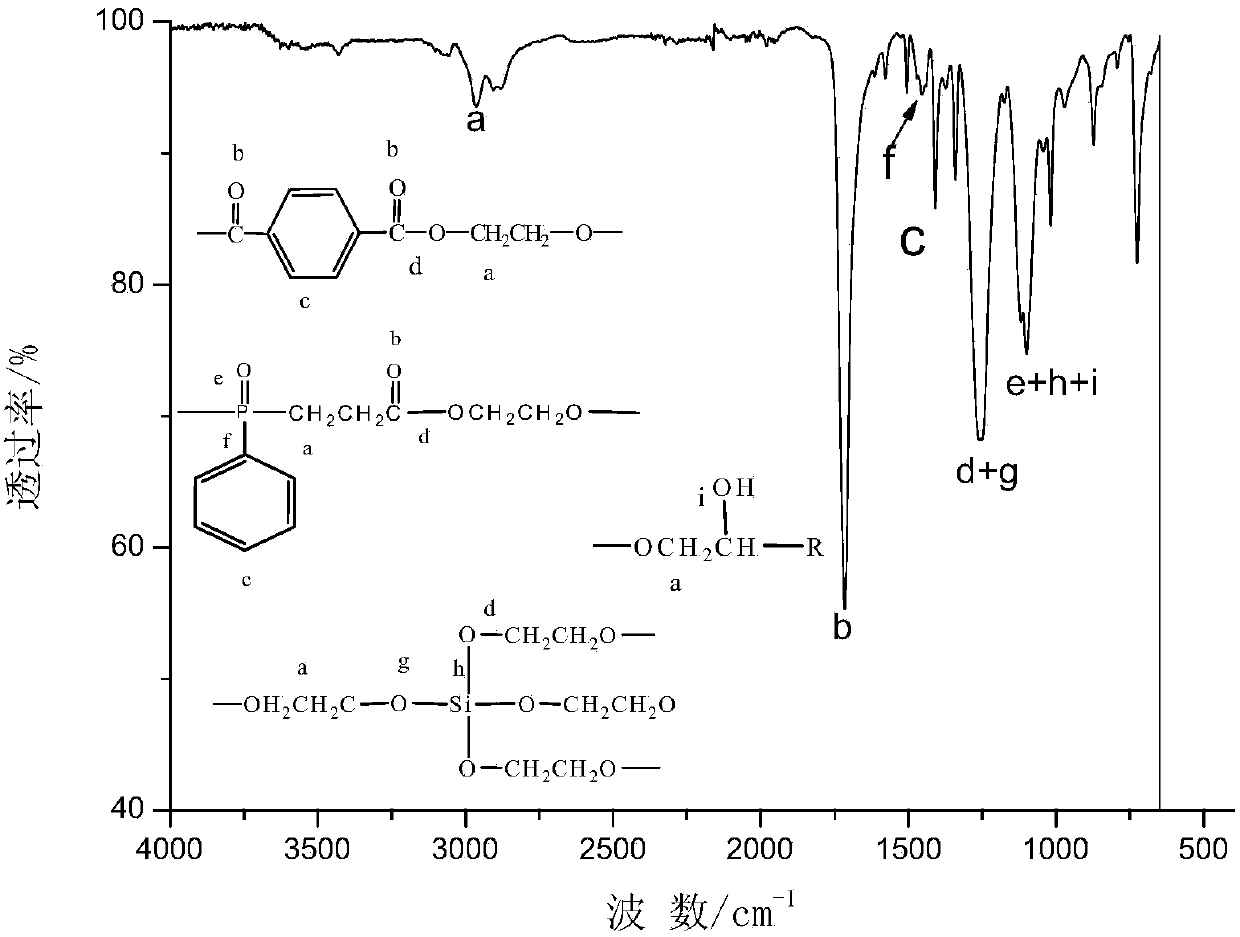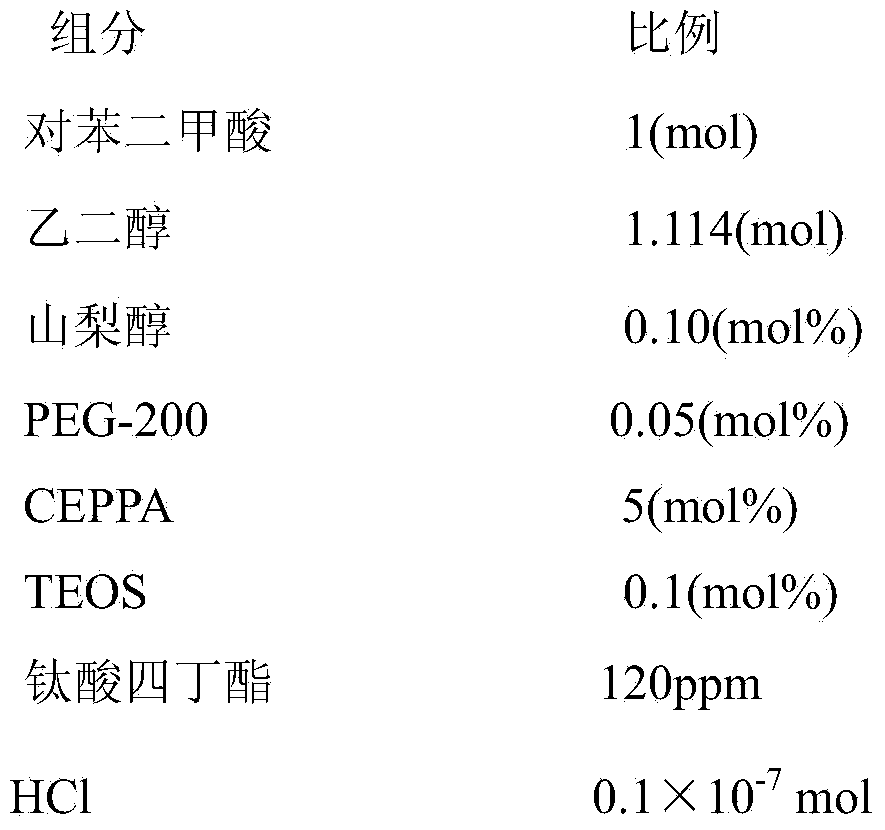Preparation method of high-hydrophilicity flame-retardant polyester fiber
A flame retardant polyester, high hydrophilic technology, applied in the direction of one-component copolyester rayon, melt spinning, stretch spinning, etc., to achieve the effect of small addition, reduced residence time, and simple process
- Summary
- Abstract
- Description
- Claims
- Application Information
AI Technical Summary
Problems solved by technology
Method used
Image
Examples
Embodiment 1
[0046]
[0047] Mix the copolymerized flame retardant CEPPA and ethylene glycol at a molar ratio of 1:1.2, and react at 100°C for 1 hour to obtain the reaction product CEPPA-EG. Mix tetraethoxysilane (TEOS) and ethylene glycol at a molar ratio of 1:4, and react under the action of catalyst HCl to obtain tetrakis (2-hydroxyethyl) orthosilicic acid solution. Mix terephthalic acid and ethylene glycol slurry at a molar ratio of 1:1.05 to prepare slurry. The prepared slurry was mixed with the catalyst tetrabutyl titanate and then put into an esterification reactor for the first esterification reaction. The temperature of the first esterification reaction was 225° C., the reaction time was 4 hours, and the relative pressure of the reaction was 0 MPa. When the esterification reaction reaches 82%, add sorbitol and polyethylene glycol (PEG-200) to carry out the second esterification reaction, the second esterification reaction temperature is 240°C, and the esterification reaction ti...
Embodiment 2
[0049]
[0050] Mix the copolymerized flame retardant CEPPA and ethylene glycol at a molar ratio of 1:1.8, and react at 100°C for 1 hour to obtain the reaction product CEPPA-EG. Hydroxyl-terminated silicone oil and ethylene glycol are mixed in a molar ratio of 1:4.4, and the catalyst SiCl 4 Under the action of the reaction, the hydroxyl-terminated silicone oil-EG solution is obtained. Mix terephthalic acid and ethylene glycol slurry at a molar ratio of 1:2.0 to prepare slurry. Mix the prepared slurry with ethylene glycol antimony, antioxidant 1010 and trimethyl phosphate, and then add it to the esterification reactor for the first esterification reaction. The temperature of the first esterification reaction is 250°C, and the reaction time is 0.5h , the relative pressure of the reaction is 0.4MPa. When the esterification reaction reaches 95%, 1,2-propanediol and polyethylene glycol (PEG-400) are added to carry out the second esterification reaction. The temperature of the ...
Embodiment 3
[0052]
[0053] Mix the copolymerized flame retardant CEPPA and 1,2 propylene glycol at a molar ratio of 1:2.0, and react at 100°C for 1 hour to obtain the reaction product CEPPA-1,2 propylene glycol. Tetraethoxysilane (TEOS) was mixed with ethylene glycol in a molar ratio of 1:4.6, and the catalyst Al(OC 2 h 5 ) 3 Under the influence of reaction, tetrakis (2-hydroxyethyl) ortho silicic acid solution is obtained. Mix terephthalic acid and ethylene glycol slurry in a ratio of 1:1.6 to prepare slurry. Mix the prepared slurry with the mixture of antimony trioxide and titanium dioxide, antioxidant 168 and alkyl phosphoric acid diester, and then put it into the esterification reactor for the first esterification reaction. The temperature of the first esterification reaction is 240 ° C. The reaction The time is 3h, and the relative pressure of the reaction is 0.3MPa. When the esterification reaction reaches 92%, 1,3-butanediol and polyethylene glycol (PEG-600) are added to ca...
PUM
| Property | Measurement | Unit |
|---|---|---|
| melting point | aaaaa | aaaaa |
| contact angle | aaaaa | aaaaa |
| melting point | aaaaa | aaaaa |
Abstract
Description
Claims
Application Information
 Login to View More
Login to View More - R&D
- Intellectual Property
- Life Sciences
- Materials
- Tech Scout
- Unparalleled Data Quality
- Higher Quality Content
- 60% Fewer Hallucinations
Browse by: Latest US Patents, China's latest patents, Technical Efficacy Thesaurus, Application Domain, Technology Topic, Popular Technical Reports.
© 2025 PatSnap. All rights reserved.Legal|Privacy policy|Modern Slavery Act Transparency Statement|Sitemap|About US| Contact US: help@patsnap.com



